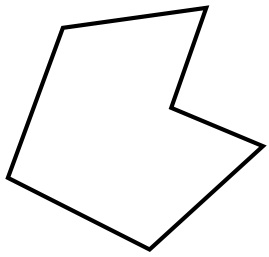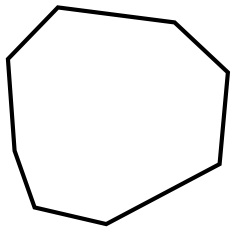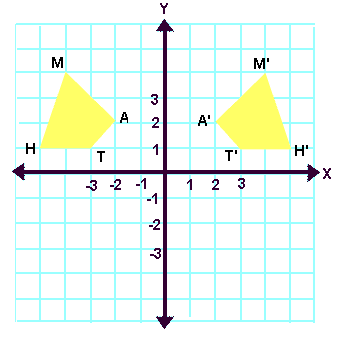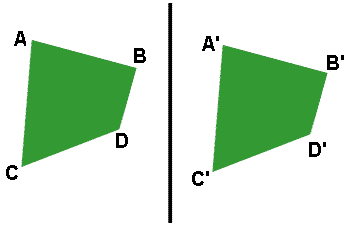Exam 1 Math 3383
(59).webp)
- 1.
A quadrilateral with opposite sides parallel
Explanation
A quadrilateral with opposite sides parallel is called a parallelogram. In a parallelogram, the opposite sides are equal in length and the opposite angles are equal in measure. The parallel sides never intersect each other. This geometric shape has several properties, such as the diagonals bisecting each other, the opposite angles being supplementary, and the consecutive angles being supplementary. Overall, a parallelogram is a special type of quadrilateral that exhibits specific characteristics based on its parallel sides.Rate this question:
- 2.
A special parallelogram with four congruent sides
Explanation
A special parallelogram with four congruent sides is called a rhombus. A rhombus is a quadrilateral with opposite sides that are parallel and congruent. It also has opposite angles that are equal. Therefore, a rhombus satisfies the given condition of having four congruent sides, making it the correct answer.Rate this question:
- 3.
A special parallelogram with four right angles
Explanation
A rectangle is a special parallelogram with four right angles. It has opposite sides that are equal in length and parallel to each other. The diagonals of a rectangle are also equal in length and bisect each other. Therefore, a rectangle fits the description of a special parallelogram with four right angles.Rate this question:
- 4.
An extra special parallelogram with four congruent sides and four right angles
Explanation
A square is a type of parallelogram that has four congruent sides and four right angles. The given description perfectly matches the characteristics of a square, making it the correct answer.Rate this question:
- 5.
What two kinds of shapes are non-parallelograms?
- A.
Kite and Trapezoid
- B.
Square and Kite
- C.
Rhombus and Rectangle
- D.
Square and Trapezoid
Correct Answer
A. Kite and TrapezoidExplanation
Non-parallelograms are shapes that do not have parallel sides. A kite is a non-parallelogram because its sides are not parallel to each other. Similarly, a trapezoid is a non-parallelogram because it has only one pair of parallel sides. Therefore, the correct answer is Kite and Trapezoid.Rate this question:
-
- 6.
A quadrilateral with two distinct pairs or congruent, adjacent sides
Correct Answer
KiteExplanation
A kite is a quadrilateral with two distinct pairs of congruent, adjacent sides. In other words, a kite has two pairs of sides that are equal in length and are next to each other. This creates a distinctive shape with two pairs of adjacent sides that are congruent. Therefore, the given answer, "Kite," is correct.Rate this question:
- 7.
A quadrilateral with one pair of parallel sides
Correct Answer
TrapezoidExplanation
A quadrilateral with one pair of parallel sides is called a trapezoid. In a trapezoid, the parallel sides are called bases, and the non-parallel sides are called legs. The bases can be of different lengths, but the opposite angles formed by the bases are always congruent. This distinguishes a trapezoid from other quadrilaterals, such as a parallelogram, where all sides are parallel.Rate this question:
- 8.
What three kinds of shapes are parallelograms?
- A.
Rhombus, Rectangle and Square
- B.
Trapezoid, Kite and Rhombus
- C.
Rectangle, Rhombus and Kite
Correct Answer
A. Rhombus, Rectangle and SquareExplanation
The correct answer is Rhombus, Rectangle and Square. A parallelogram is a four-sided shape with opposite sides that are parallel. A rhombus is a parallelogram with all sides equal in length. A rectangle is a parallelogram with all angles equal to 90 degrees. A square is a special type of rectangle with all sides equal in length. Therefore, all three shapes mentioned in the answer choices meet the criteria of being parallelograms.Rate this question:
-
- 9.
A closed 2D figure with no crossings or reuse of endpoints
Correct Answer
PolygonExplanation
A polygon is a closed 2D figure that does not have any crossings or reuse of endpoints. It is made up of straight line segments that connect to form a closed shape. The term "polygon" is commonly used in geometry to describe shapes such as triangles, squares, pentagons, and so on. These shapes have straight sides and do not intersect themselves. Therefore, the given answer "Polygon" accurately describes a closed 2D figure with no crossings or reuse of endpoints.Rate this question:
- 10.
What is Euler's Formula?
- A.
V+E-2=F
- B.
F-2=V+E
- C.
V+F-2=E
- D.
E+F+V=2
Correct Answer
C. V+F-2=EExplanation
Euler's Formula states that for any convex polyhedron, the number of vertices (V), edges (E), and faces (F) are related by the equation V+F-2=E. This means that if we know the number of vertices and faces of a convex polyhedron, we can determine the number of edges it has by substituting the values into the formula.Rate this question:
-
- 11.
3D polyhedron with a flat base where triangular lateral faces meet at an apex
Correct Answer
PyramidExplanation
A pyramid is a 3D polyhedron with a flat base where triangular lateral faces meet at an apex. The description matches the characteristics of a pyramid, as it has a flat base and triangular faces that converge at a single point, forming the apex.Rate this question:
- 12.
3D polyhedron with two bases congruent to each other and parallel lateral faces
Correct Answer
PrismExplanation
A prism is a 3D polyhedron that has two bases that are congruent to each other and parallel lateral faces. The bases are identical in shape and size, and the lateral faces connect the corresponding vertices of the bases. This arrangement creates a solid shape with flat, rectangular faces. The given description perfectly matches the characteristics of a prism, making it the correct answer.Rate this question:
- 13.
Pyramid whose lateral edges are congruent
Correct Answer
Regular PyramidExplanation
A regular pyramid is a pyramid whose lateral edges are congruent. This means that all the slanting edges of the pyramid have the same length. In a regular pyramid, the base is a regular polygon, and the height is the perpendicular distance from the apex (top point) to the base. Since the lateral edges are congruent, it implies that all the triangular faces of the pyramid are congruent as well. Therefore, the correct answer is a regular pyramid.Rate this question:
- 14.
Prism whose lateral edges meet at a right angle to the base
Correct Answer
Right PrismExplanation
A right prism is a type of prism where the lateral edges meet at a right angle to the base. This means that the edges forming the sides of the prism are perpendicular to the base. The term "right" in right prism refers to the right angle formed between the lateral edges and the base. Therefore, the given answer "Right Prism" correctly describes a prism whose lateral edges meet at a right angle to the base.Rate this question:
- 15.
What does it mean to be congruent?
- A.
Corresponding sides are congruent
- B.
Corresponding angles are congruent
- C.
No two sides have same length
- D.
At least two sides are same length
Correct Answer(s)
A. Corresponding sides are congruent
B. Corresponding angles are congruentExplanation
To be congruent means that corresponding sides and corresponding angles of two objects or shapes are equal in measure or length. This means that if two shapes are congruent, their corresponding sides will have the same length and their corresponding angles will have the same measure. The other options, "No two sides have the same length" and "At least two sides are the same length," do not fully capture the concept of congruence as they do not encompass both sides and angles being equal.Rate this question:
-
- 16.
Good conguence shortcuts
- A.
SSA
- B.
ASA
- C.
AAA
- D.
AAS
- E.
SSS
- F.
SAS
Correct Answer(s)
B. ASA
D. AAS
E. SSS
F. SASExplanation
The given answer consists of four different types of congruence shortcuts: ASA (Angle-Side-Angle), AAS (Angle-Angle-Side), SSS (Side-Side-Side), and SAS (Side-Angle-Side). These shortcuts are used to prove that two triangles are congruent based on the given information about their angles and sides. ASA states that if two angles and the included side of one triangle are congruent to two angles and the included side of another triangle, then the triangles are congruent. AAS states that if two angles and a non-included side of one triangle are congruent to two angles and the corresponding non-included side of another triangle, then the triangles are congruent. SSS states that if the three sides of one triangle are congruent to the three sides of another triangle, then the triangles are congruent. SAS states that if two sides and the included angle of one triangle are congruent to two sides and the included angle of another triangle, then the triangles are congruent.Rate this question:
-
- 17.
A quadrilateral where non-parallel sides are conguent
- A.
Kite
- B.
Parallelogram
- C.
Rhombus
- D.
Isosceles Trapezoid
Correct Answer
D. Isosceles TrapezoidExplanation
An isosceles trapezoid is a quadrilateral where the non-parallel sides are congruent. In an isosceles trapezoid, the two opposite sides are parallel, and the other two sides are congruent. This means that the non-parallel sides have the same length. Therefore, an isosceles trapezoid fits the given description of a quadrilateral where non-parallel sides are congruent.Rate this question:
-
- 18.
What is the formula for the sum of interior angles of any polygon?
- A.
2-nx180
- B.
180-n+2
- C.
N-2x180
- D.
Nx180-2
Correct Answer
C. N-2x180Explanation
The formula for the sum of interior angles of any polygon is n-2x180. This formula can be derived by dividing the polygon into (n-2) triangles, where n is the number of sides of the polygon. Each triangle has interior angles that sum up to 180 degrees. Therefore, the sum of interior angles of the polygon is equal to (n-2) multiplied by 180.Rate this question:
-
- 19.
In any polygon, the number of sides=number of vertices=number of interior angles. In other words, the amount of each are the same.
- A.
True
- B.
False
Correct Answer
A. TrueExplanation
The statement is true because in any polygon, the number of sides is equal to the number of vertices, which is also equal to the number of interior angles. This is a fundamental property of polygons and is true for all polygons regardless of their shape or size. Therefore, the amount of sides, vertices, and interior angles in a polygon will always be the same.Rate this question:
-
- 20.
Find the sum of the interior angles in a dodecagon.
Correct Answer
1800Explanation
A dodecagon is a polygon with 12 sides. To find the sum of the interior angles in a dodecagon, we can use the formula (n-2) * 180 degrees, where n is the number of sides. Plugging in the value of n as 12, we get (12-2) * 180 = 10 * 180 = 1800 degrees. Therefore, the sum of the interior angles in a dodecagon is 1800.Rate this question:
- 21.
Find the measure of each interior angle in an equiangular pentagon.
Correct Answer
108Explanation
5-2x180
3x180
540 (the SUM of the interior angles)
540/5=108Rate this question:
- 22.
What shapes are NON-POLYHEDRA?
- A.
Cylinder
- B.
Pyramid
- C.
Right pentagonal Prism
- D.
Cone
Correct Answer(s)
A. Cylinder
D. ConeExplanation
The shapes that are non-polyhedra are those that do not have flat faces. A cylinder and a cone do not have flat faces, as their surfaces are curved. Therefore, both the cylinder and the cone are non-polyhedra.Rate this question:
-
- 23.
In order to have a Regular Polygon, the shape has to be both...
Correct Answer(s)
Equiangular and EquilateralExplanation
A regular polygon is a polygon where all sides are equal in length and all angles are equal. Therefore, in order for a shape to be a regular polygon, it must be both equiangular (having equal angles) and equilateral (having equal sides). If either of these conditions is not met, the shape would not be a regular polygon.Rate this question:
- 24.
Line segment where two faces meet
- A.
Face
- B.
Base
- C.
Edge
Correct Answer
C. EdgeExplanation
An edge is a line segment where two faces meet. In geometry, a face refers to a flat surface of a three-dimensional shape, while a base typically refers to the bottom or lowest face of a solid figure. An edge, on the other hand, is the line segment formed by the intersection of two faces. It can be visualized as the boundary or border between two adjacent faces of a solid shape.Rate this question:
-
- 25.
All squares are rectangles.
- A.
True
- B.
False
Correct Answer
A. TrueExplanation
All squares are rectangles because a square is a special type of rectangle where all four sides are equal in length. Therefore, since all squares meet the criteria of being a rectangle, the statement is true.Rate this question:
-
- 26.
All quadrilaterals are parallelograms.
- A.
True
- B.
False
Correct Answer
B. FalseExplanation
The statement "All quadrilaterals are parallelograms" is false because not all quadrilaterals have their opposite sides parallel. A quadrilateral is a polygon with four sides, and a parallelogram is a special type of quadrilateral where opposite sides are parallel. However, there are other types of quadrilaterals, such as trapezoids or kites, where the opposite sides are not parallel. Therefore, it is incorrect to say that all quadrilaterals are parallelograms.Rate this question:
-
- 27.
This shape is a:
- A.
Hexagon
- B.
Convex hexagon
- C.
Mess
- D.
Concave hexagon
- E.
Hectare
Correct Answer
D. Concave hexagonExplanation
A concave hexagon is a shape that has six sides and at least one interior angle greater than 180 degrees. This means that the shape has a "caved-in" or indented portion, which is why it is called concave. In contrast, a convex hexagon would have all interior angles less than 180 degrees and no indented portions. Since the given shape is described as concave, it implies that it has at least one angle greater than 180 degrees, making it a concave hexagon.Rate this question:
-
- 28.
This shape is a
- A.
Nonagon
- B.
Octagon
- C.
Polyhedron
- D.
Somethingagon
- E.
Decagon
Correct Answer
A. NonagonExplanation
The given shape is a nonagon because it has nine sides. A nonagon is a polygon with nine sides and nine angles.Rate this question:
-
- 29.
What is the name given to this shape -
Correct Answer
heptagon
septagonExplanation
The correct answer is heptagon and septagon. Both terms refer to the same shape, which is a polygon with seven sides. "Heptagon" is derived from the Greek word "hepta" meaning seven, while "septagon" is derived from the Latin word "septem" also meaning seven. These terms are used interchangeably to describe the shape with seven sides.Rate this question:
- 30.
What is the sum of the internal angles of a triangle?
- A.
200°
- B.
90°
- C.
180°
- D.
100°
- E.
360°
Correct Answer
C. 180°Explanation
The sum of the internal angles of a triangle is always 180°. This is a property of triangles in Euclidean geometry. It can be proven mathematically by dividing a triangle into two right triangles and using the fact that the sum of the angles in a straight line is 180°. Therefore, the correct answer is 180°.Rate this question:
-
- 31.
- A.
A
- B.
B
- C.
C
- D.
D
Correct Answer
C. C -
- 32.
- A.
A
- B.
B
- C.
C
- D.
D
Correct Answer
A. A -
- 33.
- A.
A
- B.
B
- C.
C
- D.
D
Correct Answer
C. C -
- 34.
What is the type of transformation represent in this figure
- A.
Rotation
- B.
Reflection
- C.
Translation
- D.
Enlargement
Correct Answer
B. ReflectionExplanation
The figure represents a reflection because it appears to be a mirror image of itself. In a reflection, the shape is flipped over a line, creating a symmetrical image.Rate this question:
-
- 35.
Which of these figures represent reflection A B
- A.
Green figure
- B.
Pink figure
Correct Answer
B. Pink figureExplanation
The question asks which figure represents reflection A. The correct answer is the pink figure. Reflection is a transformation that flips a figure over a line. In this case, reflection A would be a flip over a specific line. Without further information about the line of reflection, we can only determine the correct answer based on the given options. The pink figure is the only one that appears to be flipped over a line, so it is the most likely representation of reflection A.Rate this question:
-
Quiz Review Timeline +
Our quizzes are rigorously reviewed, monitored and continuously updated by our expert board to maintain accuracy, relevance, and timeliness.
-
Current Version
-
Jun 22, 2023Quiz Edited by
ProProfs Editorial Team -
Oct 08, 2012Quiz Created by
Carolinechristin
- Cartography Quizzes
- Civics Quizzes
- Economics Quizzes
- El112 Quizzes
- English Quizzes
- Geography Quizzes
- History Quizzes
- Humanities Quizzes
- Law Quizzes
- Linguistics Quizzes
- Logic Quizzes
- Philosophy Quizzes
- Political Science Quizzes
- Politics Quizzes
- Science Quizzes
- Social Science Quizzes
- Sociology Quizzes
 Back to top
Back to top










